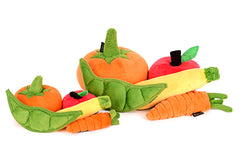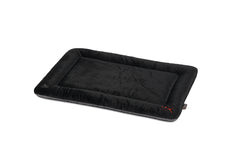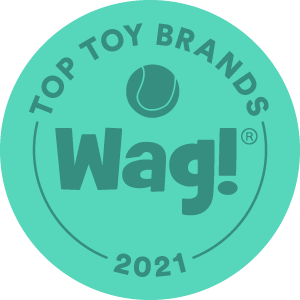When your pup is chewing, scratching, and gnawing on their paws incessantly, you might jump to the conclusion they’re reacting to something in their diet and assume it’s a dog food allergy. While this may be the case, it’s more likely something in the environment is triggering their discomfort, such as dust mites, fleas, pollen, grasses, mold, cleaning chemicals, perfumes in detergent, and shampoo.
Plus, a ‘true’ dog food allergy is uncommon. Food-related issues are more likely a result of food intolerance (aka sensitivity).
Confusing food allergies with food sensitivities is a common mistake because the outward symptoms can be very similar. However, it’s important to differentiate between the two to avoid skin and digestive upsets.
Dog Food Allergy vs Sensitivity
Food allergies and sensitivities share many of the same symptoms, but some of the symptoms are more commonly associated with one or the other.
Food Allergy: An allergic reaction to food happens when your dog’s immune system misidentifies a protein in their food as an invader and mounts an attack. It isn’t the food itself, but rather the protein structure in it . . . and it’s not just meat. Even veggies contain protein, so they’re not automatically safe. The most common dog food allergy symptoms involve skin irritation and itchiness which can evolve into more severe issues over time.
Food Sensitivity: A food sensitivity is an adverse reaction to food that does not involve the immune system (unlike an allergy). Due to an inability to metabolize an ingredient properly, some pups will have a gastrointestinal response. In most cases, it’s the meat and dairy protein in their diet that’s at the root of the issue. The most common dog food sensitivity symptoms involve a gastrointestinal reaction: diarrhea, vomiting, gas, lack of appetite, and weight loss.
Additional symptoms of food-related issues:
- Red, itchy, inflamed ears, frequent head shaking
- Hair loss
- Hives, skin rash, or inflamed skin
- Open sores or hot spots
- Coughing, wheezing, shortness of breath
- Runny, red, or itchy eyes
- Runny or stuffy nose, sneezing
- Odor from feet or ears (due to secondary bacterial or yeast infections)
- Stomach upset, gas, vomiting, diarrhea
One tip-off that your pup has an allergy as opposed to a sensitivity is recurrent (chronic) ear problems, particularly yeast infections. In addition, if their itchy skin doesn’t respond to steroid treatment or the issue returns after antibiotics are discontinued, they may be suffering from a dog food allergy.
Keep in mind, ‘true’ dog food allergies are much less frequent than food sensitivities. In fact, studies show that only 10% of dogs who do suffer from allergies (of any kind) are suffering from food allergies.
How to Pinpoint an Allergen in Your Dog’s Food
Diagnosing food allergies and sensitivities is a straightforward process involving feeding your pup a limited-ingredient diet. By reintroducing ingredients, one at a time, you can watch for a reaction and pinpoint the culprit. The process usually takes 6-8 weeks but could take as long as 12 weeks for the symptoms to resolve.
Three common approaches to the elimination trial (aka limited-ingredient diet):
- Hydrolyzed protein (prescription-only) diet provides a non-allergenic as possible nutrition
- Novel ingredient diet uses proteins like venison, rabbit, or duck instead of beef or chicken
- Carefully prepared homemade recipes formulated by a pet nutritionist
Before beginning an elimination trial (limited-ingredient diet), it’s important that all other potential problems have been ruled out. Atopy, flea bite allergies, intestinal parasite hypersensitivities, sarcoptic mange, and yeast or bacterial infections can all cause symptoms similar to food allergies and food sensitivity.
Be sure to work with your veterinarian to rule out all other potential health issues first.
What Foods Commonly Cause a Reaction?
Often, a reaction to food results from overexposure to an ingredient. So, what may have been perfectly fine for your pup to eat a year ago, might need to be eliminated from their diet.
The top offenders are commonly found in dog food:
- Beef
- Dairy Products
- Chicken
- Fish
- Chicken Eggs
A reaction to one meat protein won’t necessarily mean an allergy to other seemingly similar sources. For example, if your dog is reacting to chicken, they may be fine with turkey.
While dogs can be sensitive to plant-sourced ingredients like corn, wheat, soy, and grains, they’re actually less common allergens than many people believe.
What’s the Best Way to Manage My Dog’s Food Allergy (or Sensitivity)
Once you have identified the ingredients your pup reacts to, you’ll need to remove them from their diet.
There are a few ways to control the ingredients in your dog’s diet:
- Prepare a homemade diet: To ensure the proper balance of protein, calories, carbohydrates, vitamins, and minerals, you’ll need to consult a veterinarian or pet nutritionist to formulate a balanced and healthy recipe you can follow.
- Order custom-made dog food: There are companies that specialize in producing high quality, uniquely-formulated dog food for your pup’s specific sensitivities and dietary restrictions.
- Purchase from the pet store: You’ll need to carefully review the ingredients and researching the brand to ensure that none of the ingredients are included in the recipe. If the label is unclear, you’ll want to contact the company and double-check the ingredients.
Supporting dog food allergies and sensitivities doesn’t have to be tricky. In fact, you can take the guesswork out by working with a pet nutritionist through a company that specializes in formulating customized dog food. Ensuring that your dog has the most nutritious and balanced diet for their unique needs is one of the most important steps you can take to ensure the happiest and healthiest life.








